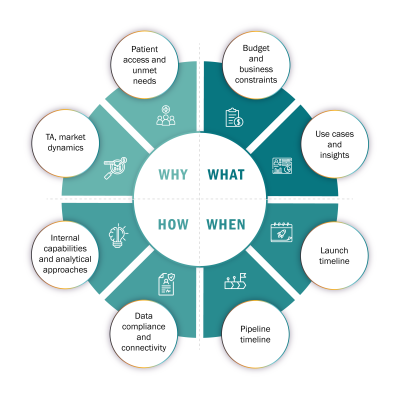Finding the right data sources and vendors can be overwhelming in today’s ecosystem. Over the years, especially with the recent surge of new data sources, many clients have told us they feel like they’re drowning in choices without a clear direction on how to make the right decisions—what we call being in the “data swamp.”
We’ve found that the right approach makes it easier to navigate this complexity and build a robust data management solution—whether you’re preparing for your first launch or scaling your commercial footprint.
The framework presented here incorporates four strategic questions and key insights we often share to help streamline and prioritize decisions about data sources and vendors, enabling a future-proof, dynamic data foundation.

1. Why do you need the data?
First, consider the therapeutic areas(s) you’re addressing and the market dynamics that drive payer, physician, and patient decisions. For example:
- Who are your competitors?
- What is emerging within your therapeutic area?
- What external factors could influence each market that you want to enter?
Then, at the patient level, consider what you need to know. For example:
- Do you understand your patient population’s specific challenges when it comes to accessing treatment?
- Are you in tune with patients’ unmet needs, such as needing better symptom management or desiring fewer side effects?
- What additional data do you need to make sure you understand patients’ pain points?
2.What will you do with the data?
The next step is gathering information about the various activities the data will need to support. Use cases are particularly helpful here, which can be developed by answering the following key questions:
- How will the data and technology be used—and by whom?
- Who are your internal stakeholders, and what are their roles, workflows, and data needs?
- Who are your external stakeholders (e.g., healthcare organizations, healthcare providers, patients), and what information do you need about them?
Documenting your budget constraints and existing data and technology contracts will also help narrow down the choices.
3. How will you work with the data?
For this step, you’re evaluating your existing capabilities and identifying gaps that you’ll need to fill. For example:
- What expertise do you have on your team?
- What capabilities will you need to outsource?
- Different data sets might require different analytical approaches, so based on the data sets you’ll need, what types of analytics will you need? Can you support these efforts in-house?
- Do the different data sources have the level of connectivity needed to easily, securely transfer data?
- Is your environment compliant for the level of data (e.g., HIPAA compliant for patient-level data)?
4. When do you need your data ecosystem to be ready?
If you’re planning for an immediate launch, it’s also useful to consider the timing of your entire pipeline to avoid drastic changes in the future or rushing from one to the other.
For your immediate launch, consider these questions:
- When is your “launch-ready” date (when you’ll have all your commercial data systems running and the field team in place)?
- Working back from that date, how much time do you have to implement the systems, purchase and integrate data then extract the insights you need before launch?
In addition, consider the following for your pipeline timeline:
- What other assets do you have in the pipeline?
- When will they be launched?
- How soon do you need to be ready for your next launch?
Although there will always be some uncertainty along the commercialization journey, using this framework can help you make the key decisions to establish a robust data foundation for both short-term and long-term success. For example, for one of our pre-commercial biopharma clients, we were able to adapt a low-and-slow approach to building out their data warehouse to be fiscally responsible, and these early investments moved them forward toward launch.
Watch our on-demand webinar for more practical steps and case studies to get your data and analytics launch-ready.

